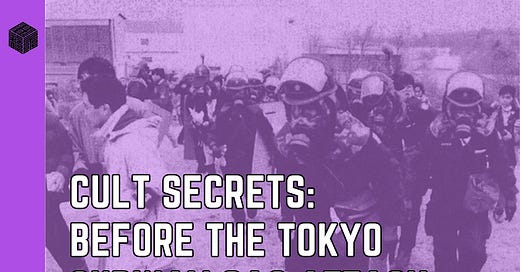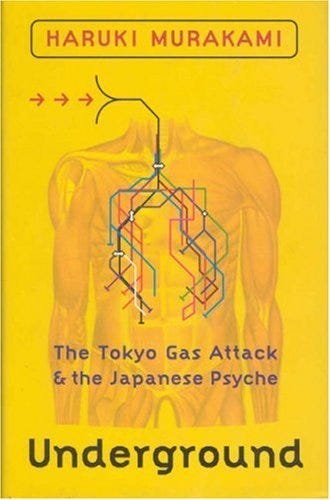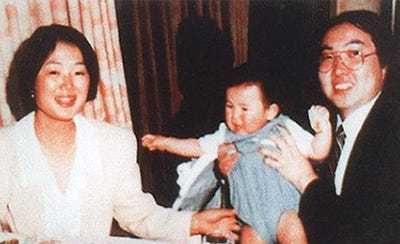Emergency personnel respond to the Tokyo subway attack. Source: unknown
You know the story, or should: on March 20th 1995 five members of the apocalyptic cult Aum Shinrikyō carried a total of 11 plastic bags filled with liquid sarin onto subway trains in Tokyo. The attackers punctured the bags with umbrellas then fled; the bags remained on the crowded trains as they travelled towards the central areas Kasumigaseki and Nagatachō, where the Japanese parliament is headquartered.
14 people died and over 1000 were injured.
The best account of the event and its aftermath is Haruki Murakami’s non-fiction Underground, which is, by the way, his best book overall. (As a card-carrying member of the cognoscenti, The Kyote’s opinion is that the other Murakami — Ryu — no relation — is the better writer. Haruki writes about the brain and heart of the Japanese people, Ryu the guts downward.)
Image: Harvill
The books subtitle “The Tokyo Gas Attack & the Japanese Psyche” is well-earned — reading it will drop jaw and raise eyebrow. A couple of short snippets from the interview with survivor Kenichi Yamazaki gives a flavor:
I don’t remember how long it was before my work colleague found me, but I do remember being furious at all the people who pretended not to see me lying there. Arseholes!
and, after being discharged from hospital with poisoning symptoms persisting:
Honestly, it would have been better for me to take some time off with sick-pay, but the company wasn’t that generous.
If you know Japan, you’ll understand exactly what he’s getting at.
These small insights appear alongside a plethora of small acts of heroism, grit, pluck and (lots of) obliviousness. Truly essential reading.
* * *
A dip into the archives of the Asahi Shimbun Newspaper gives a sense of how events evolved immediately after the attack:
SARIN GAS IN SUBWAY - 900 INJURED, 6 DEAD - TOKYO SUBWAY SARIN ATTACK (Page 1, Evening edition, March 20th)
SELF-DEFENSE FORCE CHEMICAL TEAM DISPATCHED - TOKYO SUBWAY SARIN ATTACK (Page 2, Evening edition, March 20th)
SECURITY OPERATIONS AT TRAIN STATIONS NATIONWIDE - TOKYO SUBWAY SARIN ATTACK (Page 2, Evening edition, March 20th)
“GET OUT!” - PASSENGER PANIC - TOKYO SUBWAY SARIN ATTACK (Special Supplementary Evening edition, March 20th)
TREATMENT? MEDICINES? - TOKYO SUBWAY SARIN ATTACK (Regional Evening edition, March 20th)
POLICE ON ROUND-THE-CLOCK ALERT - TOKYO SUBWAY SARIN ATTACK (Morning edition, March 21st)
10 CONFIRMED DEAD - TOKYO SUBWAY SARIN ATTACK (Morning edition, March 22nd)
PHOSPHORUS COMPOUNDS FOUND - SARIN PRECURSOR - AUM-CONNECTED FACILITY (Morning edition, March 23rd)
BOTTLES AND BOXES WITHIN PLASTIC BAGS - AUM SHINRIKYŌ FACILITY SEARCHED (Morning edition, March 23rd)
SEARCH LASTS MORE THAN 10 HOURS - AUM SHINRIKYŌ (Morning edition, March 23rd)
* * *
What will have struck you is the pace of events — amid the panic and muddled testimony you’d expect from a mass casualty incident, the very first newspaper published after the attack already nails the chemical agent involved, and then, within 72 hours, the police have raided the Aum Shinrikyō facility where the sarin was synthesized.
You get the impression, then, of some quite brilliant investigative work.
Not so fast.
In fact, March 20th 1995 was the second fatal sarin attack that Aum had carried out; in June the previous year they killed 7 and injured hundreds in Matsumoto City while trying to assassinate the judges hearing a fraud case against the cult.
And a month before that they poisoned a lawyer who led a legal group named the Canary Association assisting victims of Aum’s “disconnection” policy.
The lawyer, Taro Takimoto, in fact survived no less than four attempts on his life: the sarin assault was followed by attacks with botulinum and VX nerve agent (twice)…
…and VX was quite a favorite of the Aum nutbags, actually, who also used it to kill a couple dozen of their own dissident members during a particularly brutal edition of ones of those internal purges that always occur within insane religious organizations.
Far from a rapid police response, in fact the only comparison in the realm of law enforcement/intelligence incompetence is Director of Central Intelligence George Tenet reacting to the 9/11 attacks by saying “I wonder if it has anything to do with those guys taking pilot training in Florida.”
The Sakamoto family. All three were murdered by Aum. Image: Wikipedia
* * *
Aum was founded by Shoko Asahara in 1987 in his one-bedroom apartment in Tokyo's Shibuya as a yoga and meditation class. By 1989 it gained official status as a religious organization and attracted a considerable number of graduates from Japan's elite universities.
The “Aum Salvation plan” included rubbish on curing physical illnesses, realizing life goals by improving intelligence and positive thinking, and “concentrating on what was important at the expense of leisure” — usual cult language for making members work incredibly long hours to exhaust and prime them for indoctrination.
Years before the Tokyo gas attack, a certain TV network was preparing a special on Aum and, as part of their research interviewed another lawyer, Tsutsumi Sakamoto, who was working on a class action lawsuit against the cult, charging them with manipulating their members into committing their incomes to buying worthless spiritual doo-dads.
With Aum facing the prospect of bankruptcy if the lawsuit succeeded, when they learned of the upcoming documentary they approached the television network, and — in one of the great historical failures to protect one’s sources — the network handed over interview tapes they had recorded with Sakamoto on the basis they would be kept confidential.
This sealed the lawyer’s fate.
Aum put together a hit squad to break into the Sakamoto family home in the deep night of November 5th 1989, and murdered him, his wife and their 14-month-old son, Tatsuhiko, with a combination of hammers and syringes of potassium chloride.
Their bodies were dismembered, teeth smashed to prevent identification, then the carnaged remains were poured into barrels to be hidden in three separate rural areas.
These murders were not uncovered until after the Tokyo attack 6 years later.
(The Tokyo Metropolitan Police Department had received a tip that an Aum member was involved in the murders and in 1991 launched an investigation but, in one of those outrageous jurisdictional turf-disputes that crop up often in the history of crime in Japan, they shut down the probe due to the killings having been committed outside of their jurisdiction, in next-door Yokohama).
As for the television network involved (Tokyo Broadcasting System), even after the Tokyo subway attack they denied that they had handed over the tapes, up to and including in the face of questions in Parliament — a farcical position to take, as multiple arrested Aum members were by that time readily testifying as to what had happened.
It took another year before the upper management belatedly resigned in disgrace.
* * *
So, what was motivating these butchers? Your basic doomsday crap, essentially.
Founder Shoko Asahara was a believer in a decisive Holy War of destruction with the all-powerful United States, which needed to be nudged into existence via widespread horrific killings with chemical and/or biological weapons (there is a suggestion that Aum’s branch in Russia made some hapless attempts to gain nuclear capabilities too).
Some sources argue the whole problem began when Asahara’s inner circle, which, as behooves a messianic religious freak, initially consisted mainly of young, attractive and low self-esteemed women, started to be replaced with men, who were far more aggressive and encouraged their leader’s belief that a cleansing nuclear war could be ushered by the homemade chemical/biological warfare campaign.
This, it goes without saying, is as piss-poor an excuse as God has yet allowed for murdering innocent people.
Aum lunatic-in-chief Shoko Asahara (right). Not, it’s safe to say, the Dalai Lama’s finest hour. Image: Archivos de la Historia
* * *
So, how was an apocalyptic cult allowed to roam free for years?
One reason was a lack of press scrutiny — with cults mainly banished from the news due to the Sengoku Jesus case.
In 1979, a Bible group leader born Takeyoshi Sengoku attracted negative attention when the families of some of his — sigh — young, attractive and low self-esteemed followers accused him of luring their daughters away from their homes.
“The Ark of Jesus”, Sengoku’s group, began an odyssey around Japan trying to escape the ensuing press attention, but to no avail.
Amid feverish media attention, the self-styled new Jesus suffered a very public collapse and ensuing hospitalization.
Sengoku Jesus, floored by angina, plus distraught followers. Image: Mainichi Shinbun
In the aftermath, prosecutors declined to indict the sickly but still living Sengoku Jesus for his alleged kidnap and financial exploitation of his followers, and the group faded back into obscurity. The press, however, had become leery of criticizing fringe groups, something which led to fatal consequences for Aum’s victims.
* * *
A longer Aum taxonomy would include examination of these further outré elements:
Aum’s attempt (with perfect upside-down cult logic) to get the heat off after the worldwide outrage following the Tokyo gas attack by launching another series of attacks, this time with hydrogen cyanide…
the broad daylight fatal samurai sword-stabbing of Aum’s third-in-command by a yazuka gangster — a event which is essentially Japan’s version of Jack Ruby’s rub-out of Lee Harvey Oswald…
But there is one last Aum event that must be mentioned, one which reaches the heights of lunatic dudgeon: in 1992, three years before the Tokyo subway assault, cultmaster Asahara led more than 40 of his followers on a mission to Zaire, with the supposed intent of rendering aid to victims of Ebola, then ravaging the country.
However, it seems almost certain that the actual purpose of the trip was to collect samples of the Ebola virus to bring home to Japan and later weaponize.
Aum wasn’t just shunting around Japan with complete impunity on a multi-year chemical-and-biological weapons death rampage, they were also jetting off on international proliferation field trips.
(By this point, despite the horror — or maybe because of it — we’ve almost achieved (pitch) black comedy. The Zaire escapade reminds The Kyote of 1998’s berserk Hong Kong cinematic provocation Bio-Zombie).
Then came March 20th 1995…
More:
Until next time,
The Kyote







